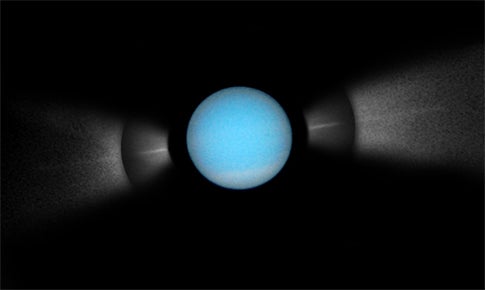This series of images from NASA’s Hubble Space Telescope shows how the ring system around the distant planet Uranus appears at ever more oblique (shallower) tilts as viewed from Earth — culminating in the rings being seen edge-on in three observing opportunities in 2007. The best of these events appears in the far right image taken with Hubble’s Wide Field Planetary Camera 2 on August 14, 2007.
The edge-on rings appear as two spikes above and below the planet. The rings cannot be seen running fully across the face of the planet because the bright glare of the planet has been blocked out in the Hubble photo (a small amount of residual glare appears as a fan-shaped image artifact). A much shorter color exposure of the planet has been photo-composited to show its size and position relative to the ring plane.
Earthbound astronomers only see the rings’ edge every 42 years as the planet follows a leisurely 84-year orbit about the Sun. However, the last time the rings were tilted edge-on to Earth astronomers didn’t even know they existed.
With further analysis of the Hubble data, astronomer Mark Showalter of the SETI Institute in Mountain View, Calif., hopes to detect some of the small moons that may shepherd the debris into distinct rings.
Until Voyager 2 flew by Uranus in January 1986, the rings were only known from the way they temporarily blocked the light of stars passing behind the planet. Hubble provided some of the first images of the ring system as viewed from Earth’s distance of approximately 2 billion miles. The advent of adaptive optics gave ground-based observers using large telescopes comparatively sharp views.
The rings were discovered in 1977, so this is the first time for a Uranus ring crossing to be observed from Earth. Earth’s orbit around the Sun permits three opportunities to view the rings edge-on: Uranus made its first ring crossing as seen from Earth on May 3; it made its second crossing on August 16; and will cross for the third time on February 20, 2008. Though the last ring crossing relative to Earth will be hidden behind the Sun, most of Earth’s premier telescopes, including Keck, Hubble, the European Southern Observatory’s Very Large Telescope and the Hale Telescope on Mt. Palomar, plan to focus on the planet again in the days following December 7, 2007. On December 7 the rings will be perfectly edge-on to the Sun.
Showalter is a member of a team led by Imke de Pater of the University of California, Berkeley, who reported that the rings of micron-sized dust have changed significantly since the Voyager 2 spacecraft photographed the Uranus system 21 years ago. Observations were also gleaned from near-infrared adaptive optics observations with the Keck II telescope on May 28, 2007, and reported in an article appearing on August 23 in Science Express, the online edition of Science.










